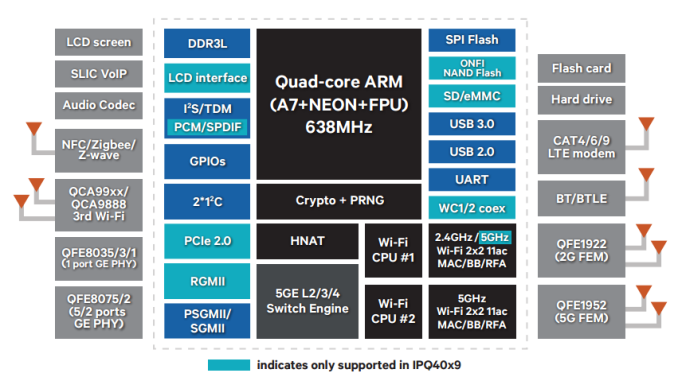Qualcomm Launches New GigaDSL, 802.11ac Wave 2 Chipsets
by Joshua Ho on May 30, 2016 9:00 PM EST
At Computex today, Qualcomm Atheros announced a few new chipsets, and it seems that as a part of their Ikanos acquisition they’ve entered the wireline business in the hopes of solving capacity issues in the last mile. While fiber should be deployed where possible, in many cases it can be expensive and impractical to run fiber optic cable, such as older apartment complexes. As a result, a 10 Gbps connection can turn into a 100 Mbps connection when using POTS lines for the last few hundred meters depending upon channel conditions and run length.
G.fast or GigaDSL attempts to bridge the gap here by using techniques like self far-end crosstalk cancellation and significantly increased transmission bandwidth to significantly improve channel utilization of existing POTS lines, and the QCO5700 and QCM5720 use these technologies to try and improve bandwidth at the last hundred meters. Unlike previously launched chipsets, these are really designed to enable drop-in replacement for existing VDSL equipment, and are squarely targeted at Asian ISPs that generally have an all-fiber network but may only have POTS in a building. The QCO5700 is designed for multiple dwelling deployments like apartment buildings, while QCM5720 is designed for customer premises equipment and both chipsets can support up to 1Gbps while coexisting with existing services that may also be using the POTS line.
The other notable announcement here is on Atheros’ traditional wireless business, and as a part of trying to get better connectivity for the last few feet in the home. While MU-MIMO is nothing new at this point, QCA is releasing a new tri-radio platform for routers the QCA9886 2x2 802.11ac radio. With three radios, a single router with an IPQ40x9 SoC will be able to support simultaneous 2.4 GHz, 5 GHz, and a third 5 GHz radio for range extender use.
The new GigaDSL chipsets should begin sampling in June, and companies like Sumitomo Electronics, NEC, and Wave Electronics are designing or building products that will utilize the QCO5700 and QCM5720. The new QCA9886 is already sampling to vendors, and should be in routers in the near future.










3 Comments
View All Comments
beginner99 - Tuesday, May 31, 2016 - link
Last mile is for sure a huge issue not just in Asia. There is a fiber line less than that from the place I live but we are not connected. Phone company says max they can offer is 40 mbit/s (down, up like 4 MBit/s). I said not thanks and wen with cable which is decent in down (250Mbit/s) but also sucks at upload. In fact upload is slower than advertised due to old cabling in building...DanNeely - Tuesday, May 31, 2016 - link
40mbit down is within the operational speeds for VDSL/VDSL2; and means you're probably close to a mile away from the nearest box servicing your area (if you were closer a faster tier would be available). The next generation service in this tech only has about 100m effective range (before it tapers down to VDSL2 levels); less for the highest service tiers. The service tier you were offered means this probably wouldn't help you at all even if deployed without additional fiber buildout.It's only really usable on streets that have fiber running down them already (or in denser urban areas adjacent streets). Effectively it's the last step before fiber to the home for landline phone companies; to deploy it they'll have to run fiber down most streets but can still leave the existing POTS connections from the utility lines to individual residences intact until the next round of build-out. (At which point they'll be able to offer faster service than cable ISPs; instead of being stuck as second best.)
iwod - Tuesday, May 31, 2016 - link
It is exciting to see G.Fast finally taking off. Hopefully we will get this to market ASAP.